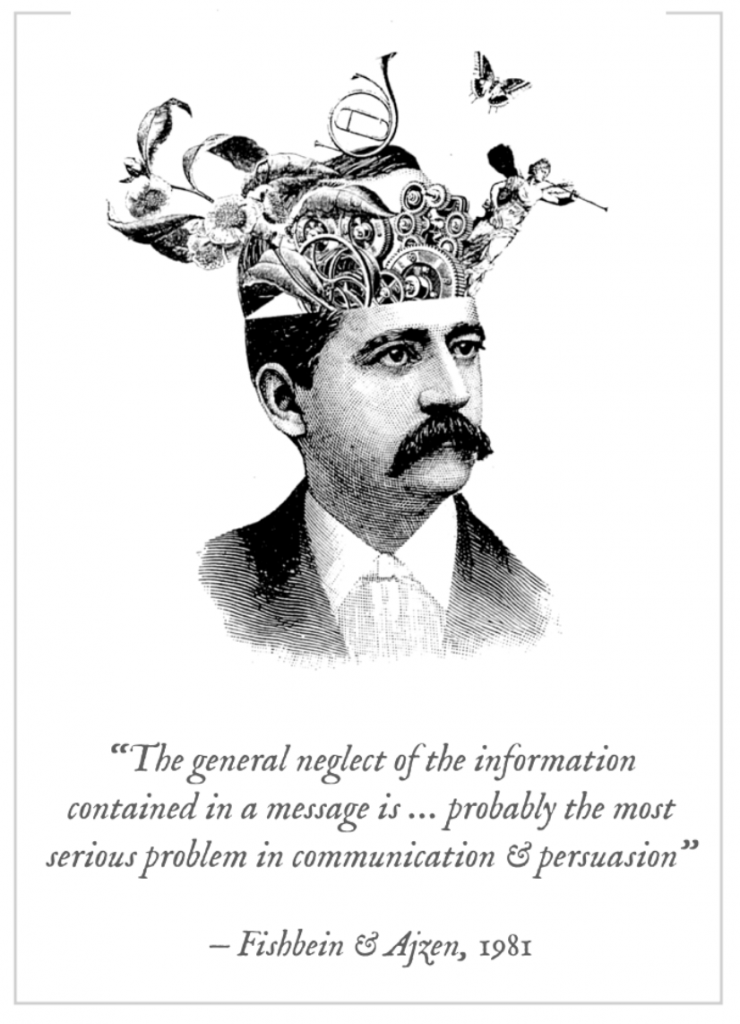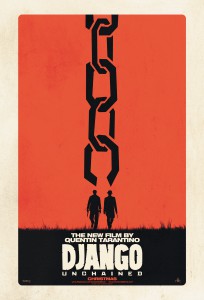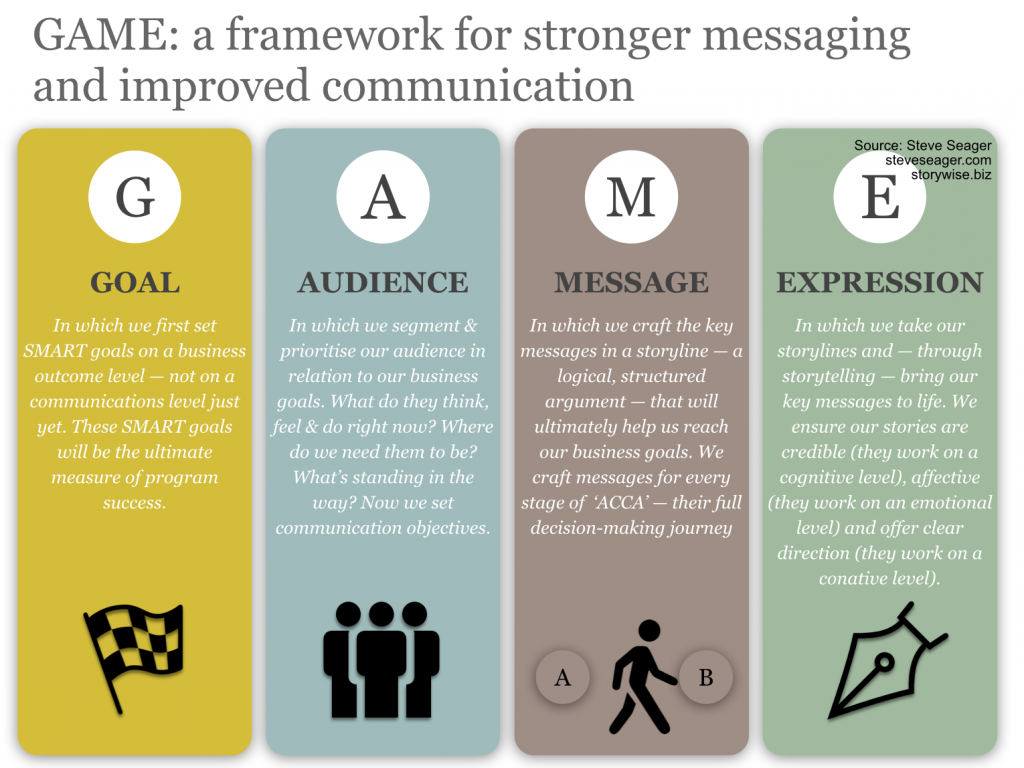As a rule, every business discipline has tried and tested processes and techniques others can understand, learn, and even apply for themselves. These give credence to that discipline. Communication is often seen as an exception to the rule — its success determined by the art of storytelling. In reality, it’s not true. Welcome to GAME, a four step process to improve the quality of your communications, and storylining, the step that comes before storytelling.
You know you have to step up your core communication skills when:
• An incredible 83% of execs say their business strategy isn’t well understood internally (Strategy&, 2014)
• 85% of marketers fail to connect their content marketing with any business value (BMA/Forrester, 2014) and;
• Fewer than 50% of communicators believe all of their work is aligned with strategy and goals (AlignYourOrg, 2014).
With all the hype on storytelling today you’d be forgiven for thinking that it is the ultimate panacea to all business communication ills — and that great business and brand stories are the result of an arcane creative process that only comms-types are privy to.
It’s a nonsense. The truth is, the communications industry is seriously under-performing, and storytelling is not the solution.
Don’t get me wrong; stories are valuable in business and yes, there is an art to telling great business stories. But moving straight to storytelling without first crafting strong, logical, persuasive key messages for the right stage of a decision-making or buying journey, positioning or proposition, inevitably results in a ‘failure to communicate’ …
… Regardless of how good your storytelling is.
 Some time ago I participated in a consulting process for an international financial organisation undergoing a digital transformation. From a slick ESN to funky infographics, next-level storytelling, comics, and the five archetypes of content — they had it all down to a ‘T’.
Some time ago I participated in a consulting process for an international financial organisation undergoing a digital transformation. From a slick ESN to funky infographics, next-level storytelling, comics, and the five archetypes of content — they had it all down to a ‘T’.
Still, in our meeting, one of the senior business line communicators asked me why their messages don’t ‘cascade’. I answered: ‘Considering all your great storytelling? It’s got to be poor messaging.’ Half of the team laughed, the other furrowed their brows.When we dug a little deeper it seemed that, virtually without fail, the team took the core strategy from senior management — complete with big slogan-y statements — and moved straight to storytelling.
The problem is that when we don’t take the time to think from our audiences’ perspective — and craft the messages they need to trigger them through every stage of their decision-making journey — our stories won’t stick.
As the single most important element of communication across all disciplines, crafting powerful and persuasive key messages needs to be the one area in which business communicators excel.
Introducing storylining
To be frank, the few specialists with I have encountered with a truly rigorous message development technique are mostly associated with management consulting firms — mainly McKinsey & Company.
The technique is ‘storylining’. It has been successfully applied to all manner of internal and external strategic communication programs and outputs over the years. And I believe it should considered a core leadership competency — especially, of course, for communicators.
In essence, storylines are to plot what storytelling is to dialogue.
Think of your favourite film. Long before a scriptwriter began writing dialogue, a screenwriter sat down to craft a plot designed specifically to draw people through a full journey towards a particular resolution.
It is only once this plot is strong — complete with a credible beginning, middle and end — that a scriptwriter comes on the scene and starts applying all their great storytelling techniques to help make the plot come alive.
An example: During a stint with the BBC I worked on the Horizon documentary series — which often deals with complex subject matter and makes it accessible and persuasive to all. All program ideas were judged first on their storyline (their plot). Only when the storyline was strong, would the search start for the right storyteller.
We business communicators should approach our business and brand stories the same way. Storylines are the core logic and argumentation — in words — of our strategy, campaign or program. They should be the basis of all the stories we go on to tell.
Storytellers love a good storyline too
In my experience, all good storytellers love a strong storyline. Storylines are like a business and creative brief all in one. They give total clarity on what needs to be communicated, complete with a specific outcome. And they offer a clear audience decision-making sequence that informs creative concepts too.
As a result, storytellers can work quicker, smarter, be more creative — and are guaranteed to get more impact from their storytelling too.
So. Bearing in mind that our ‘failure to communicate’ lies most often in our actual messaging, and that any story is only as good as the storyline that underpins it, one thing is clear: storytelling is NOT the ultimate communication weapon — storylining is.
Down below is ‘GAME’ — a framework for improving the results of any strategic communication — within which we can develop our storylines.
GAME (Goal, Audience, Message, Expression)
GAME is the overall framework and the ‘M’ in GAME is the part where we create our storylines. In summary:
• Goal: in which we establish clear business-level outcomes from our communication
• Audience: in which we define audience and key issues in relation to our goals and set communication objectives.
• Message: in which we craft a storyline — the key messages in a logical argument — that will move our audience from ‘A’ to ‘B’.
• Expression: in which we find the best way to express our messages — that’s storytelling.
Check out this example from FastCompany on how business leaders can use this framework to gain influence from a single communication moment.
Then, we’ll take another look and put more emphasis on storylining — the ‘M’ in GAME.
1. Goal
Set SMART goals. Think on a business outcome level — on the tangible results of a desired positioning or proposition — not on a communications level yet. You will tie them together later with your communication objectives and key messaging.
2. Audience
Segment and prioritise your audience. Make sure you understand their issues in relation to your goal. What do they think, feel and do right now? Where do you need them to be? Set communication objectives.
3. Message
Now we craft the key messages — in a logical, well structured argument — that will drive our audience through their decision-making journey towards our desired outcome.
For now, I suggest using ‘ACCA’ (Awareness, Comprehension, Commitment, Action) as the four steps you will need to guide your audience through — and develop messaging for. It is a great all-purpose model.
These four steps are a hierarchy of communication effects model, which ensures you cover all the behaviour influencing stages: knowing, feeling and doing, which are required to truly persuade an audience (more on the models within this framework at the end of this document).
• Awareness: in which we help our audience become aware of the challenge we are tackling
• Comprehension: in which we help our audience understand the solution we propose
• Commitment: in which we provide the proof that our solution is the right one
• Action: in which we craft a clear call to action that lets our audience know what to do next.
Structuring the messages in a logical way is crucial to get consistency and clarity throughout all four stages. Sorry to say, this is the area in which the majority of communicators fail. We’re great at generating stickies — but not too hot at shaping them into a coherent structure.
Barbara Minto’s Pyramid Principle is the right tool to use here. To get you started, here’s 10 great lessons on how to structure business communication.
And the last step in GAME is …
4. Expression
With strong storylines in place, and using our key messages as the foundation, we can now focus on how best to bring those messages to life. That is storytelling.
The world is not exactly short on storytelling advice, so I will offer just one strong rule of thumb built on the same three elements of behaviour change I mentioned earlier: knowing (cognitive), feeling (affective) and doing (conative).
• Logic: make sure your story makes sense from your audience point of view
• Emotion: make sure your story engages on a human level
• Direction: make sure your audience knows exactly what to do next.
How to play the GAME
The next time senior management or a client asks you to develop a communication strategy or end-product, don’t rush straight into storytelling.
Instead, first set clear business goals. Do your audience analysis in relation to those business goals and set clear communication objectives. Design your key messaging — put most of your effort here! Then, and only then, begin storytelling.
No matter what sort of content you will end up producing, or even which type of strategy you are communicating, storylining is the one thing guaranteed to get you better results.
Finally, once you become fluent in storylining you will also be much better equipped to design messaging for today’s more complex decision-making journeys in our digital world. But that, as they say, is another story entirely.
— Steve
The models behind the GAME framework
CAB (Cognitive, Affective, Behavioural): A route to behaviour change through persuasive communication drawn from social psychology and often applied to consumer behaviour — Rosenberg & Hoyland, Yale 1960.
ACCA (Awareness, Comprehension, Commitment, Action): An adapted hierarchy of communication effects model traditionally used in the advertising industry — Colley, 1961.
Pyramid Principle: Barbara Minto’s (ex-McKinsey) methodology to help develop and structure business communications in a logical fashion for more impact.

















